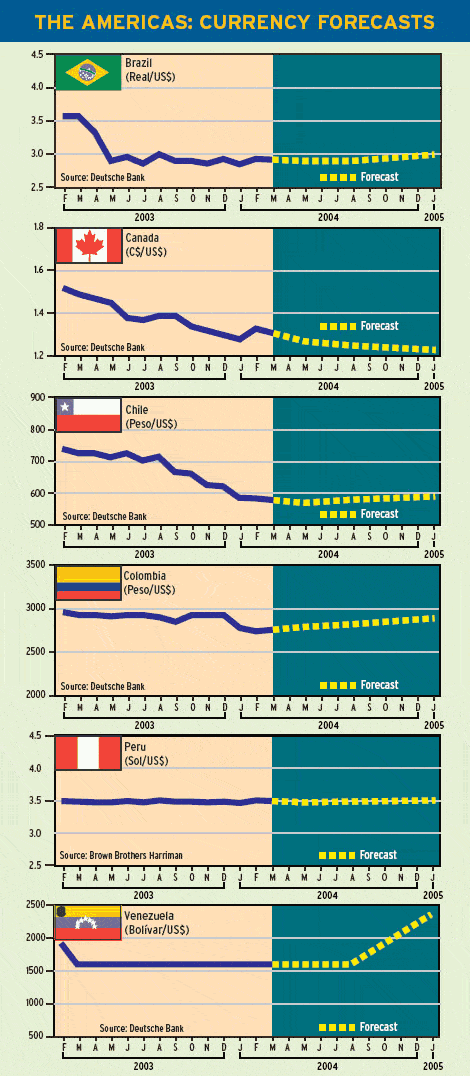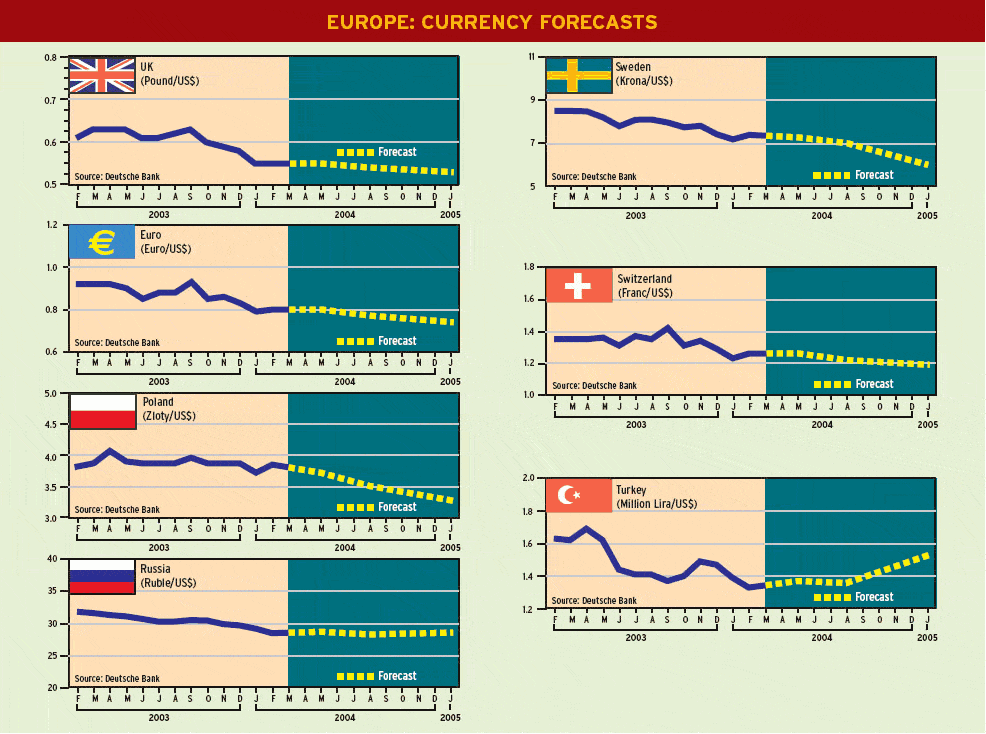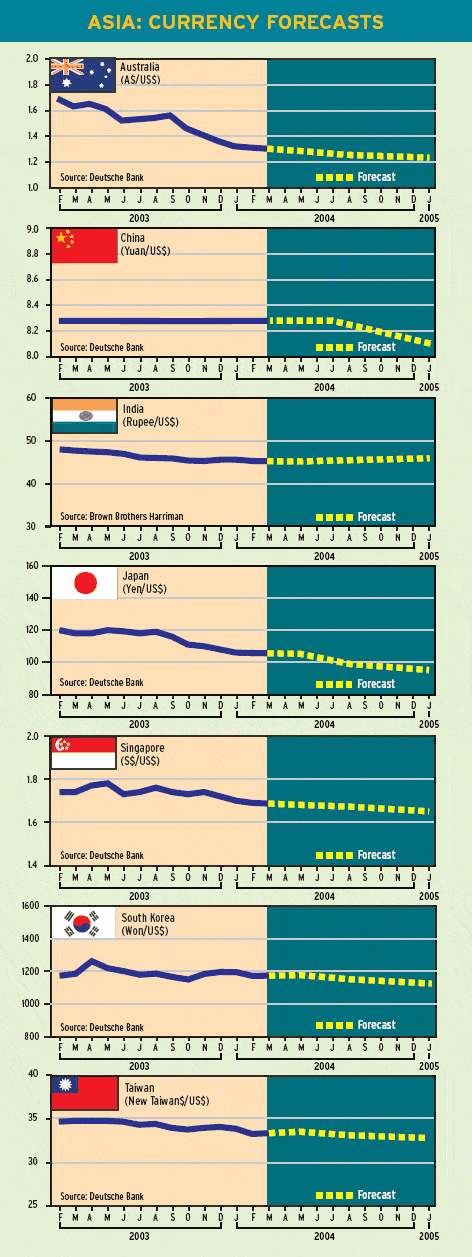THE AMERICAS

In a move that came as a surprise to some analysts, the Group of 7 industrial nations warned against excessive volatility and disorderly foreign exchange movements in its communiqu following the groups early-February meeting in Boca Raton, Florida. The dollar jumped nearly 1% against the euro in a knee-jerk reaction to the G-7s statement, which was seen as an acknowledgment by the US that the dollars steep fall was harming Europes exports and threatening to disrupt the regions fragile economic recovery.
The dollars rebound was short-lived, however, as market participants concluded that the G-7s words were unlikely to be backed up by action, and that the weakening of the dollar would be allowed to continue as long as the pace of the decline did not become too rapid. In a matter of hours, the dollar gave back all of its gains. The need for the US record current account deficit to adjust does not end with Boca, says David Gilmore, partner and economist at Essex, Connecticut- based Foreign Exchange Analytics.
With US monetary and fiscal policy squarely aimed at fostering strong domestic demand, the avenue for adjustment in the US current account deficit remains a weaker dollar, Gilmore says. Moreover, given the absence of full-speedahead monetary and fiscal policies in Europe and Japan aimed at elevating domestic demand, the euro and yen have to play a part in the adjustment mechanism, he says.
What the G-7 really means in its desire to avoid excessive volatility is about future rates of appreciation of the euro against the dollar, and not past rates, according to Gilmore.No one, especially the US,wants a run on the dollar, he says. The G-7s warning about excessive volatility was the first since 1999, says Marc Chandler, chief currency strategist at HSBC Bank USA in New York.
The Boca statement, however, fell far short of the 1987 Louvre Agreement, which set specific target zones for the major currencies.There was no commitment on the part of any of the G-7 participants in Florida to either intervene in the currency market to offset any potential disorderly movements, or to adjust monetary policy.
However, historical precedents suggest that unilateral European intervention should not be ruled out entirely, Chandler says. Between the Plaza Agreement to drive the dollar down in 1985and the Louvre Agreement to stabilize the dollar in 1987, there was the Gleneagles Accord in September 1986, he says. Gleneagles led to large-scale European intervention in support of the dollar for several weeks. As is the case in American football, a strong running game often creates favorable conditions for a pass play, Chandler says. Material intervention by the European Central Bank would enhance the credibility of its verbal intervention. While there seemed to be nothing in the G-7 statement to suggest that the dollars decline is going to be reversed, some analysts believe the dollar could be due for a period of relative stability. The US dollar has much further to fall before it hits bottom, but the next leg of its decline has been postponed until the spring, says Michael Rosenberg, global head of foreign exchange research at Deutsche Bank in New York.
The dollar selloff is still coming, but it will be put off for some time, Rosenberg says.I am still a huge dollar bear, but going into the G-7 meeting, the dollar was oversold and it will need a period of consolidation. It has taken just two years of persistent dollar weakness to reverse the gains that the dollar enjoyed over the previous five years, Rosenberg says.

The historical evidence on exchange-rate movements indicates that currency cycles tend to be highly persistent, often lasting many years before an eventual reversal is set in motion, Rosenberg says. If the present dollar cycle conforms to a typical cycle, the dollar should continue trending lower over the balance of 2004, 2005 and likely 2006, he says. Rosenberg says the US agreed to the G-7s warning about excessive volatility because Bush administration officials feared that a further dollar selloff would have negative implications for US stock and bond markets.
EUROPE/ASIA
Adjustment Burden Tilts Toward East
The European nations succeeded in Boca Raton in putting the onus for exchange-rate flexibility squarely on Asia, and in particular on China, which is not a member of the G-7 club. French finance minister Francis Mer says the G-7 statement means that the euro has adjusted enough.
Analysts say the pressure is building on China to allow the value of its yuan currency to appreciate. We now forecast that by end-June China will change its yuan peg from the dollar to a basket of 10 currencies, says Rebecca Patterson, currency analyst at JPMorgan Chase in New York.
As part of this adjustment, we see a one-off modest yuan revaluation to a round number of 8.00 to the dollar,Patterson says. China has kept its currency pegged at a fixed exchange rate to the dollar of 8.28 for the past decade. By the end of 2004, JPMorgan Chase expects the yuan to be trading at 7.80 to the dollar.
Japan has made it clear, meanwhile, that it has no intention of changing its foreign exchange policy. Sadakazu Tanigaki, Japans finance minister, says he told US Treasury secretary John W. Snow in Boca Raton that currencies should reflect market fundamentals in a stable manner and that it is up to each nation to act against excesses.
Japans foreign exchange reserves rose by a record $68 billion in January, indicating that the country stepped up the pace of its intervention, which reached a record $189 billion for all of 2003. Traders say Japan received implicit approval from the G-7 to continue intervening, mainly because its US Treasury bond purchases are critical to financing the US budget and current account deficits.

Gordon Platt



